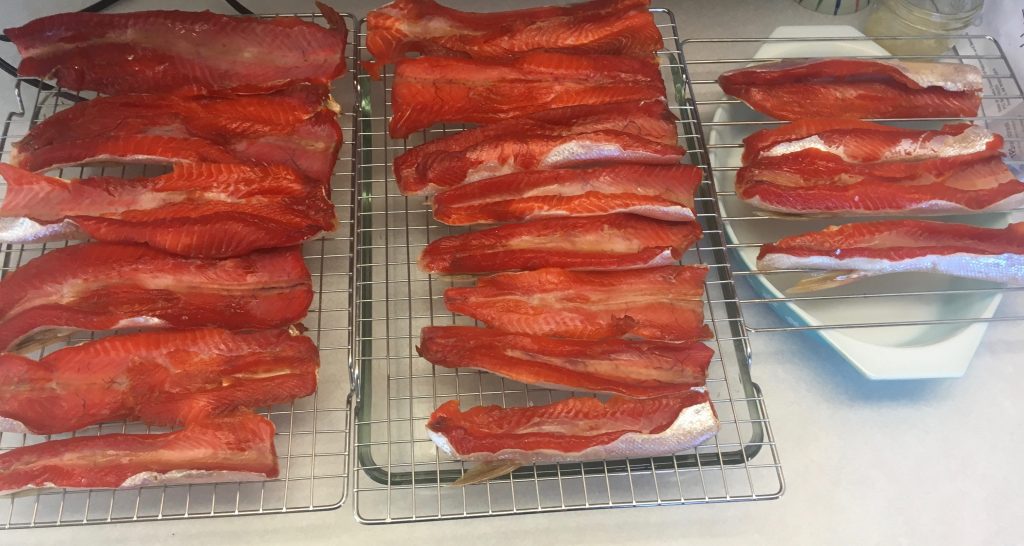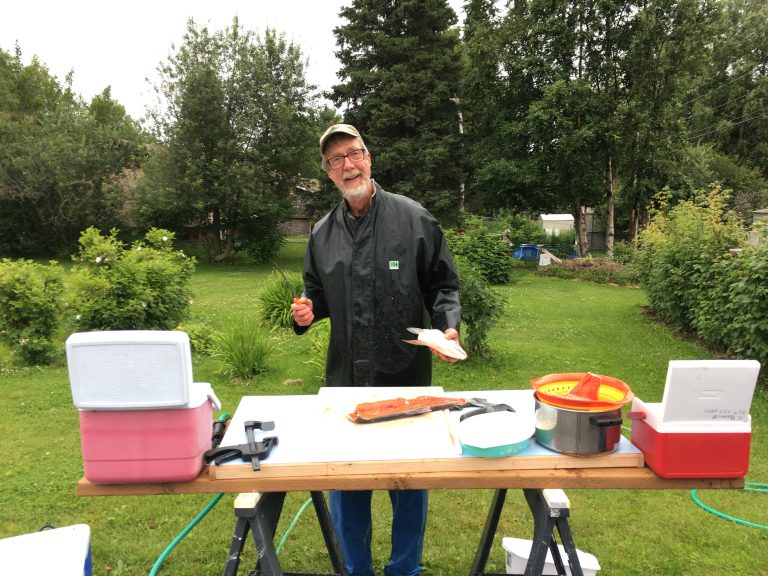The author at his backyard prep station. Photo by James P. Bennett.
My work often brings me to western Alaskan villages, and, invariably, my Yup’ik friends will point out pictures of fleshy salmon carcasses and fish heads littering Kenai beaches during dipnetting openings. They wonder why anyone would waste so much incredibly good food. Silently, I’ve had to confess I’ve been guilty as charged. Although we had already taken baby steps to better care for the netted fish and to use more of what we harvested, my girlfriend, Jessica, and I decided that last season, we would try to use 100 percent of each salmon we caught.
We gambled on going dipnetting mid-week during the early side of the late July red run, primarily to beat the crowds. We packed up the car and left Anchorage at 5 a.m. Nets were in the water by 9:30. The first salmon slammed into the webbing soon after.
Back when I caught all my salmon on a fly rod, I learned to keep the meat tasty and visually appealing after months in the freezer simply by slicing gills and bleeding each fish as they were caught. I don’t bonk their heads or gut them as it could bruise the meat and expose it to bacteria. As a Kenai dipnetter, I would never beach-side fillet and rinse the flesh in the turbid Cook Inlet water as the city’s sewage treatment plant is at the mouth of the river. Thousands of gulls relieve themselves in the area and hydrocarbons from the drift fleet and private boaters also taint the water. We place bled salmon in coolers half-filled with ice and repeat the routine until we fill two chests. Twenty-some fish were plenty for the two of us and by three that afternoon, we more than met our goal.
We drove back to Anchorage that day, but were too tired to begin processing. I added ice to the coolers and put them in the garage. Soon after, we went to bed to get an early next-day start.
Processing salmon and using the whole fish

Waiting is a strategy that I will permanently adopt. Both Jessica and I were refreshed after a solid sleep and were anxious to begin transforming salmon into future feasts. It took us the day to do it right, but the work never seemed chore-like as it often did when I was cold and tired. Also, we were blessed with sunshine and no bugs. My knife hand sliced to the rhythm of a funky playlist. We paused for feasts of fish with greens pulled from our garden: a blackened salmon salad for lunch and fish tacos for dinner. It was joyful to connect directly with sea and soil. That very day, some of our backyard raspberries were ripe to eat.
Fresh greens from one of the author’s raised beds.
Organization is a personal challenge, but I’ve learned to create a more efficient workstation. I have a waist-high table, and there’s enough room for a big plastic cutting board, two small coolers for roe and bellies, and a plastic tub to toss entrails. With fish that has been bled, there is no need for gutting before cutting fillets. If it’s a female fish, I remove and rinse the roe. In the house, Jessica rinses and vacuum-seals the salmon.
Russian friends taught me the alchemy of rendering roe into tasty caviar, and it’s wonderfully easy. Last year, we experimented with freezing excess caviar; otherwise we would need to eat all the roe within a week. I love it on omelets or spread on homemade dark bread that has been smothered in goat cheese and garnished with dill and cilantro from the garden. Pair it with a gin and tonic and you have a perfect hors d’oeuvre.

I’m embarrassed to admit that I didn’t start harvesting salmon bellies until five years ago. Smoked salmon bellies are like bacon, except better. There’s no one right way to cure salmon bellies or strips of fillets. Jessica prepares a dry brine of brown sugar, salt, and spices, and it comes out of the smoker tender and tasty. I use a wet brine and vary the recipe depending on what I have on hand and it turns out fine. We’ve learned that gravlax is an easy-to-make delicacy akin to lox. It’s now a permanent part of our salmon preparation repertoire.
Two years ago, I started making fish stock from the backbones; last year, we decided also to use the head, liver, and heart to make broth. As the heads and bodies simmered, the remaining flesh began separating from the bones. Jessica picked off the residual meat as the stock cooled. We were able to put away an extra 12 packages of salmon meat and 12 quarts of stock that are perfect for soups, tacos, and fish cakes throughout the winter. For us, that’s like harvesting an additional 10 salmon!
We buried all of the entrails along with the meat-stripped carcasses and heads deep within our compost heaps. The rich soil that’s created helps grow our vegetables, herbs, and berries. My Kenai friends freeze all of their waste and wait until bears hibernate before composting.
Dipnetting the Kenai River
Dipnetters get a bad rap on the Kenai and not without cause. It’s about impossible to make a left-hand turn in July unless you’re at a light. Motorists are impatient and inattentive. Lines in stores are long. The beaches are crowded and as people clean fish and toss guts, eggs, and heads back in the inlet, hundreds of gulls foul the water (pro tip: bring a hat!). As the tide goes out, a carcass graveyard appears on the sand. It’s not a pretty sight. It’s understandable that locals get annoyed by the hordes.
Despite all of that, there is much to like about dipnetters. Most everyone is nice. I’ve had fun conversations with strangers fishing next to me. I’ve talked about traditions with folks whose ancestors have harvested Alaskan salmon for thousands of years. I’ve discussed history and culture with others who have recently become residents after migrating from various parts of the globe. I’ve shared accounts of kayaking, climbing, and skiing with young adults who moved here for adventure and are embracing all parts of the Alaskan lifestyle. I’ve met plenty of folks like me who have raised families here and have dipnetted for years. I like that it’s an all-ages and gender-neutral activity. We are all equal on the beach. Jessica caught more fish than I did this year. Her fish were bigger, too.

After two days of catching and processing all of the salmon we would need for a year, Jessica and I kicked back a little. She sat in the backyard sun and caught up on reading. I slowly rowed around a nearby lake. That night, we had friends over for dinner, and we prepared a Chinese-style noodle soup made from our smoked salmon, broth, and garden produce.
The Kenai River provides sustainable food for masses of ordinary residents, and that is unique in the world. It’s an egalitarian resource to be valued for the wholesomeness it offers to so many people. Wild salmon should be used wisely and protected forever.


Comments are closed.